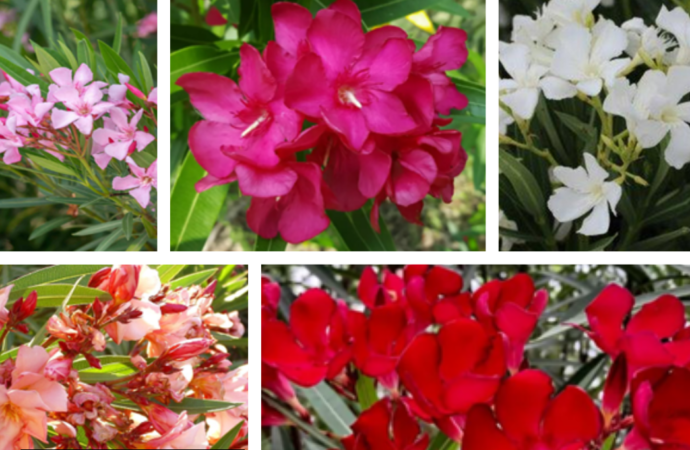Author: Dr. Sunitha Paulose
Introduction
Nerium oleander, often simply called oleander, is an incredibly lovely plant that is frequently used in decorative gardening and landscaping. Nevertheless, this beautiful plant conceals a terrible secret: it is among the world’s most poisonous plants. The strong poisonous chemicals in oleander pose serious health hazards even with its widespread use. This article investigates the botanical Characteristics toxicity of oleander and looks into its lethal beauty.
Botanical Characteristics
Oleander belongs to the Apocynaceae family and is native to the Mediterranean region. It grows as a shrub or small tree and can reach heights of 6 to 20 feet. The plant produces clusters of fragrant flowers in various colors, including white, pink, red, and yellow. Its leaves are long, narrow, and dark green, adding to its allure in gardens and landscapes.
Adaptability and Hardiness of Nerium Oleander
Nerium oleander is renowned not only for its aesthetic appeal but also for its remarkable adaptability and hardiness. These characteristics contribute to its widespread use in various landscapes. Nerium oleander’s adaptability and hardiness make it an excellent choice for a variety of landscapes, particularly in regions that can capitalize on its drought tolerance and resilience to adverse conditions. However, its toxicity requires mindful placement and handling to ensure safety.
Overview of Oleander Toxicity
There are several varieties of oleander, each distinguished by unique flower colors and forms. Despite their differences in appearance, all parts of the oleander plant contain potent toxins that can be dangerous if ingested. Oleander contains cardiac glycosides, primarily oleandrin, which can cause severe poisoning. These toxins disrupt the heart’s electrical activity, leading to potentially fatal arrhythmias. Both humans and animals are at risk, making awareness and proper handling of this plant crucial.
Common Varieties of Oleander
In India, pink and yellow oleanders are the two most prevalent varieties of oleanders. For the most part, both are cardiotoxic. The majority of these plants that are cardiotoxic contain different cardiac glycosides that function similarly.
-
Nerium Oleander ‘Petite Pink’
Several popular names for this plant include adelfa, laurier rose, rose francesca, rose laurel, rose bay, and white oleander. It is a large evergreen ornamental shrub belonging to the family Apocynaceae, with clusters of white or pink flowers (Fig 1). All parts of the plant are poisonous, especially the leaves, stem, seeds, and root. The following active toxins are present—oleandrin, neriin, folinerin, rosagenin, and digitoxigenin. These are cardiac glycosides and have digoxin-like effects, acting by inhibiting the sodium–potassium adenosine triphosphatase (Na-K-ATPase) pump.

Fig 1:Nerium Oleander ‘Petite Pink’
-
Nerium Oleander ‘Calypso’
`Calypso’ has single, cherry red flowers and is very hardy. Often trained into an attractive small tree, multi-branched Oleander also does well as a quick-growing screen or large specimen planting (Fig:2). All parts of the plant are poisonous so care must be taken when locating Oleander near areas frequented by small children; burning of the trimmings will produce toxic fumes.

Fig2: Nerium Oleander ‘Calypso’
-
Nerium Oleander ‘Hardy Red’
Hardy Red Oleander will grow to be about 12 feet tall at maturity, with a spread of 12 feet Planting beneath power lines is appropriate for this somewhat lanky plant, which normally has a clearance of two feet from the ground. It is highly tolerant of both dry and wet environments, and it ought to thrive in typical residential landscaping circumstances. Given its reputation for being drought-tolerant, it’s a great option for xeriscaping or moisture-conserving landscaping.

Fig3: Nerium Oleander ‘Hardy Red’
-
Nerium Oleander ‘Sister Agnes’
`Sister Agnes’ has single pure white flowers. Often trained into an attractive small tree, multi-branched Oleander also does well as a quick-growing screen or large specimen planting (Fig: 3)

Fig4: Nerium Oleander ‘Sister Agnes’
-
Nerium Oleander ‘Mrs. Roeding’
‘Mrs. Roeding’ has double pink flowers. Often trained into an attractive small tree, multi-branched oleander also does well as a quick-growing screen or large specimen planting. All parts of the plant are poisonous so care must be taken when locating Oleander near areas frequented by small children; burning of the trimmings will produce toxic fumes.

Fig5: Nerium Oleander ‘Sister Agnes’
Toxic Compounds in Nerium Oleander
Nerium Oleander containing a variety of potent compounds that can pose severe health risks to humans and animals.The primary toxic components of oleander are cardiac glycosides, including oleandrin, oleandrigenin, and neriine. These compounds affect the heart’s electrical activity and can cause severe poisoning even in small amounts.
- Oleandrin and Neriine:
These are the most significant toxic constituents of oleander. Cardiac glycosides affect the heart’s contractile force and can lead to serious cardiovascular issues. Oleandrin (Fig:6), in particular, inhibits the sodium-potassium ATPase pump, which is critical for maintaining the electrochemical gradients across cell membranes, especially in cardiac tissues.

Fig 6: Oleandrin
- Saponins:
These compounds contribute to the plant’s toxicity by affecting cellular membranes and potentially causing hemolysis (destruction of red blood cells). Saponins ( Fig:7) can irritate the gastrointestinal tract, leading to symptoms like nausea, vomiting, and diarrhea.

Fig 7: Saponins
- Oleandrin and Digitoxigenin:
Both are structurally similar to digoxin (Fig:8), a well-known cardiac medication. These compounds bind to and inhibit the sodium-potassium ATPase enzyme, leading to increased intracellular calcium concentrations, which can cause cardiac arrhythmias and other serious heart conditions.

Fig 8: Digitoxigenin
Mechanism of Toxicity
Cardiac glycosides interfere with the sodium-potassium pump in heart cells, leading to increased intracellular calcium levels (Fig:9). This disruption can cause cardiac arrhythmias, a condition where the heart beats irregularly, which can be fatal. Additionally, oleander toxins affect the gastrointestinal system and the central nervous system.

Fig 9: Diagram illustrating how cardiac glycosides, such as oleandrin, inhibit Na+/K+-ATPase in cardiac myocytes
Symptoms of Poisoning
Ingestion of any part of the oleander plant can result in a range of symptoms:
- Gastrointestinal: Nausea, vomiting, diarrhea, and abdominal pain.
- Cardiac:Irregular heartbeats, bradycardia (slow heart rate), or tachycardia (rapid heart rate).
- Neurological: Dizziness, confusion, drowsiness, and in severe cases, coma.
Conclusion
The Nerium oleander, with its alluring beauty and strong toxicity, is a remarkable illustration of nature’s dichotomy. Although the plant is a popular choice for attractive gardening because to its vibrant flowers and evergreen foliage, the plant’s deadly cardiac glycosides pose serious health risks. It is important to use caution when handling and cultivating oleanders because of our understanding of the mechanisms underlying their toxicity, especially with regard to how they affect the heart’s electrical activity. To ensure that oleander is enjoyed safely and responsibly and to prevent accidental poisonings, it is imperative that the public be made aware of the risks involved with this lethal beauty.
 Food Manifest
Food Manifest 

















